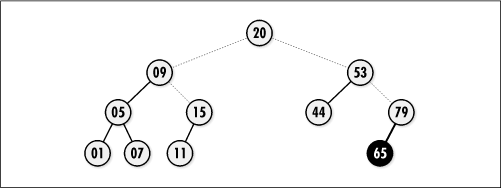Description of Binary Search Trees
Binary search trees are binary trees organized specifically for searching. To search for a node in a binary search tree, we start at the root of the tree and descend level by level until we find the node we are looking for. When we encounter a node greater than the desired node, we follow its left pointer. When we encounter a node that is less, we follow its right pointer. For example, to locate 15 in the tree of Figure 9.7, start at the root and move to the left since 15 is less than 20, then to the right since 15 is greater than 09, at which point we find 15. If we reach the end of a branch before locating the desired node, it does not exist.
Of course, the process of searching a binary tree depends on nodes having been inserted in a similar way. Thus, to insert a node, we start at the root of the tree and descend level by level, moving left or right as appropriate. When we reach the end of a branch, we make the insertion. For example, to insert 65 into the tree of Figure 9.7, we start at the root and move to the right since 65 is greater than 20, then to the right again since 65 is greater than 53, and then to the left since 65 is less than 79. This point is the end of a branch, so we insert the key as the left child of 79. Duplicate keys are not allowed.

Get Mastering Algorithms with C now with the O’Reilly learning platform.
O’Reilly members experience books, live events, courses curated by job role, and more from O’Reilly and nearly 200 top publishers.

